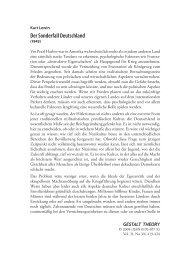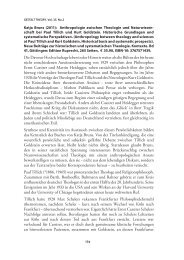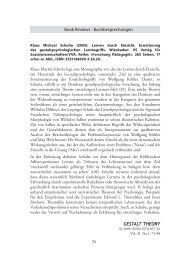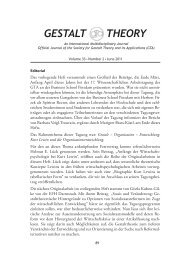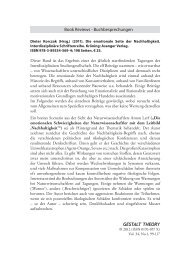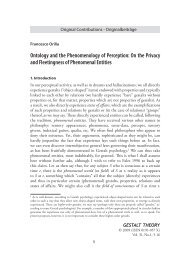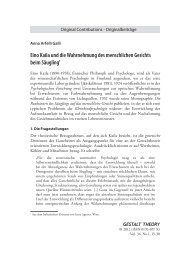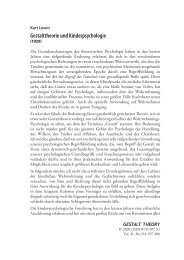What is the Meaning of Shape? - Gestalt Theory
What is the Meaning of Shape? - Gestalt Theory
What is the Meaning of Shape? - Gestalt Theory
You also want an ePaper? Increase the reach of your titles
YUMPU automatically turns print PDFs into web optimized ePapers that Google loves.
417<br />
Pinna, <strong>What</strong> <strong>is</strong> <strong>the</strong> <strong>Meaning</strong> <strong>of</strong> <strong>Shape</strong>?<br />
<strong>the</strong> more reason for <strong>the</strong> notion <strong>of</strong> happening. In fact, in <strong>the</strong> case <strong>of</strong> <strong>the</strong> beveled<br />
square, <strong>the</strong> square appears as <strong>the</strong> amodal whole object and <strong>the</strong> beveling as <strong>the</strong><br />
modal part <strong>of</strong> it. The square <strong>is</strong> <strong>the</strong> result <strong>of</strong> <strong>the</strong> amodal wholeness completion <strong>of</strong><br />
something perceived as its v<strong>is</strong>ible modal portion. The square <strong>is</strong> perceived and not<br />
perceived at <strong>the</strong> same time and its amodal whole completion occurs “beyond” <strong>the</strong><br />
beveling. Th<strong>is</strong> implies that <strong>the</strong> amodal completion can be considered as a subset<br />
or as an instance <strong>of</strong> <strong>the</strong> more general problem <strong>of</strong> amodal wholeness. In <strong>the</strong> case <strong>of</strong><br />
<strong>the</strong> beveled square, <strong>the</strong> amodal wholeness corresponds to <strong>the</strong> amodal prägnanz.<br />
Th<strong>is</strong> suggests that every shape manifests an ideal condition where one meta-shape<br />
attribute emerges much more than o<strong>the</strong>rs. In o<strong>the</strong>r words, each shape indicates<br />
amodally its starting or converging point <strong>of</strong> singularity. Therefore, we are able to<br />
perceive how a figure can be changed or accentuated to obtain <strong>the</strong> best condition<br />
under which <strong>the</strong> shape becomes a singularity. It <strong>is</strong> worthwhile noticing that, on<br />
<strong>the</strong> bas<strong>is</strong> <strong>of</strong> our results, <strong>the</strong> gradient <strong>of</strong> v<strong>is</strong>ibility <strong>of</strong> <strong>the</strong> shape attributes indicates<br />
that, when one attribute emerges, <strong>the</strong> o<strong>the</strong>rs remain inv<strong>is</strong>ible or in a second plane<br />
<strong>of</strong> v<strong>is</strong>ibility.<br />
In conclusion, <strong>the</strong> meaning <strong>of</strong> shape, here suggested, allows its extension to<br />
conditions never included in <strong>the</strong> notion <strong>of</strong> shape so far. They are, for example,<br />
<strong>the</strong> material properties, previously considered as shape attributes (see section<br />
5.6), but also figures like those illustrated in Fig. 21, known as “Maluma-Takete”<br />
(Köhler, 1929, 1947; see also Ramachandran & Hubbard; 2001), where two<br />
opposite attributes are perceived, curviness and pointedness, and where a large<br />
set <strong>of</strong> fur<strong>the</strong>r opposite properties – smoothness and sharpness, jaggedness and<br />
roundedness – are related to <strong>the</strong>se ones.<br />
Fig. 21 Maluma and Takete





